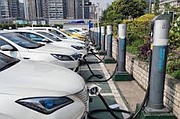By CHRIS ILLING
CCO @ ActivTrades Corp
POLITICIANS worldwide are fighting over carbon dioxide prices, domestic flights and kerosene taxes to slow down climate change. The goal is to limit the global rise in temperatures to two degrees. But most energy forecasts are of the opinion that we are losing this battle. With this in mind, it is no surprise that car manufacturers are trying to do their part to make the world a greener place.
Battery powered and hybrid vehicles are experiencing a surge in demand all around the world. In 2019, only 2.6 percent of all cars sold globally were electric. In 2022, these vehicles accounted for around 13 percent of all autos sold. This increase in demand is good for business, and the leading car manufacturers are competing over which model has the longest range, best design and best price point.
The Auto Show in Shanghai, which began last Tuesday, is the most important event of its kind since before the COVID pandemic. E-vehicles are dominating this trade fair, and the once-leading manufacturers such as Volkswagen (VW), Ford, and General Motors (GM) are increasingly being left behind by Chinese competitors in this booming market. The sheer mass of Chinese vehicles is striking - 650 models from 60 Chinese brands, and almost all with electric drive. China’s politicians have strongly promoted electro-mobility in China, which has strengthened manufacturers over the past few years. A lot of these young, modern car companies have the advantage of extremely agile organisational structures and processes. They can produce faster and more affordably compared to traditional car companies. Influencers for local brands are flooding social media, creating a cool trend, and young Chinese are increasingly buying local products.
This development has already had an effect on Germany’s Volkswagen, which sold 14 percent less vehicles in China in 2022 compared to 2021. The Japanese carmakers are trying to catch up, but have to accept they have missed the boat on the push for electrification. The new kids on the block, such as BYD or NIO, have already taken over from the established brands in regard to the number of cars sold in the first quarter of 2023.
Electric vehicles are forecast to be over 50 percent of global car sales by 2035, and around 73m by 2040. Experts predict that profitability for the car manufacturers will increase, while the cost for the consumer decreases.
Just as in the competition between the car manufacturers, we can see increasing competition between the countries that harvest the important raw materials to produce electric vehicle batteries. A large chunk of the cost of an electric vehicle is its battery, which can account for as much as 40 percent of the expense. For example, Chile has the largest lithium reserves in the world. President Gabriel Boric wants more control over mineral resources, and plans to nationalise the lithium industry. This could have consequences for partnerships with Volkswagen, Mercedes and others. Chile is the world’s second largest producer of the metal after Australia, and the demand is increasing rapidly with the transition to a climate-friendly economy. Mining is currently in the hands of industry giants, and they have contracts with Tesla, LG Energy or Mercedes, for example. But, in the future, a state-owned company will have control over the extraction of the raw material using public-private partnerships (PPPs). Mexico nationalised its lithium deposits last year. The country is aiming for a lithium alliance with the governments of Argentina, Bolivia and Chile. Under the IRA (Inflation Reduction Act) in the US, which aims to promote domestic assembly of electric vehicles as well as the location of battery assembly and material production, companies will not be able to use the battery supply chain that has been built up in China to export to the US.






Comments
Use the comment form below to begin a discussion about this content.
Commenting has been disabled for this item.